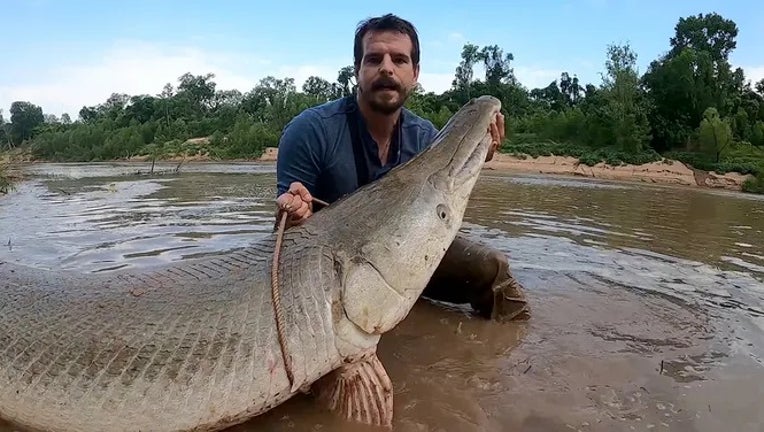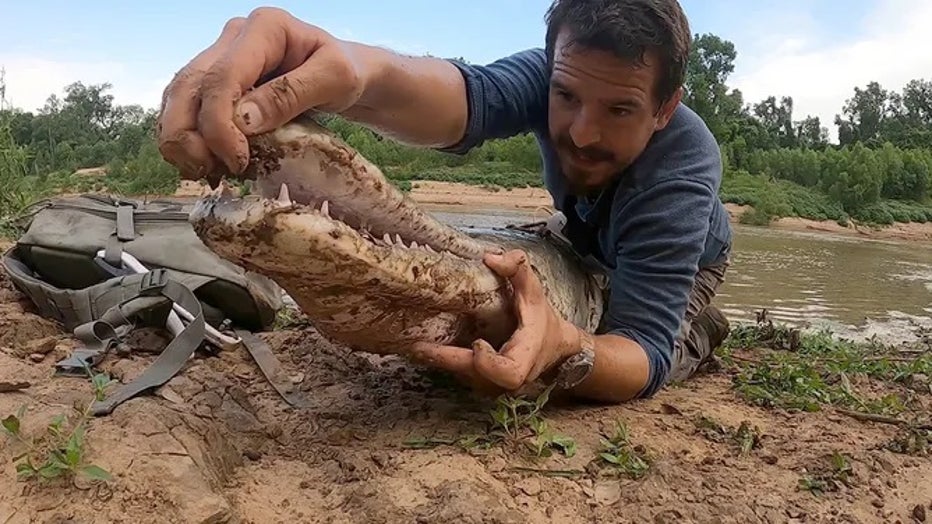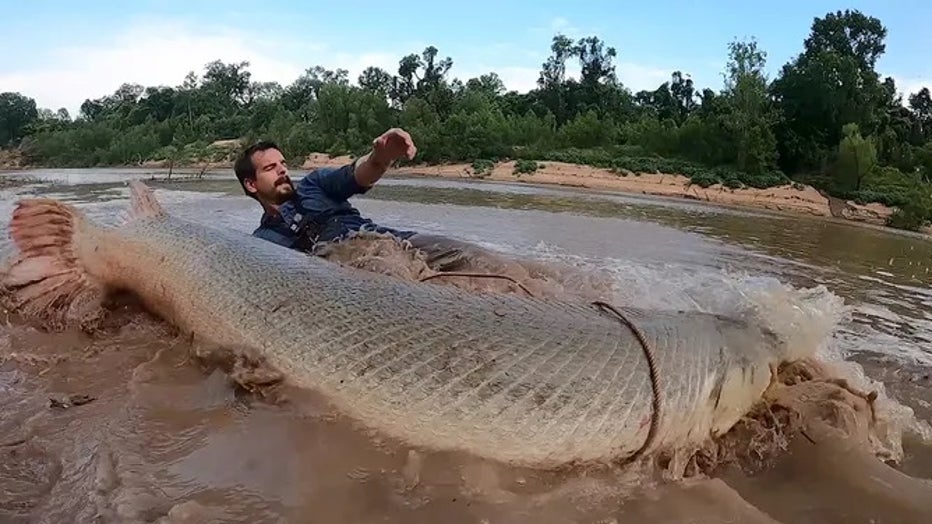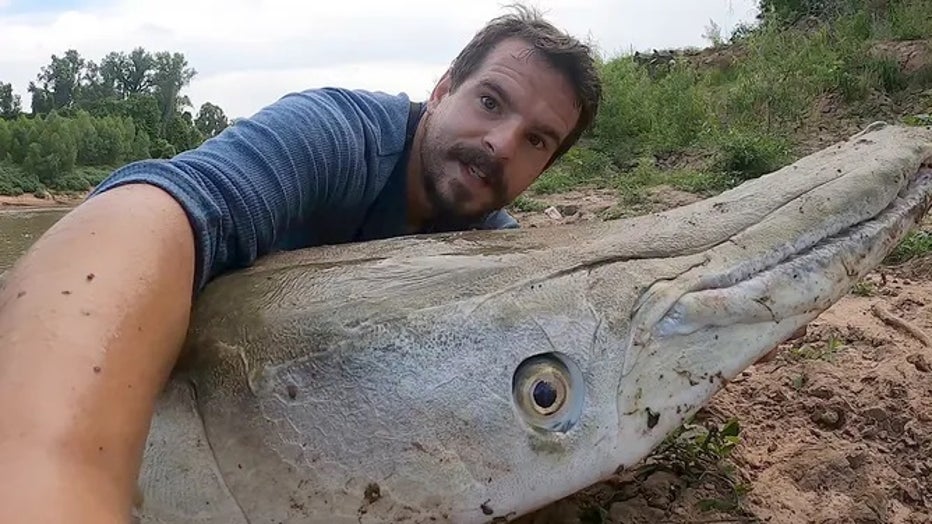Texas trophy: Man hooks 300-pound alligator gar outside Houston

Alligator gar are the second-largest freshwater fish in North America, second only to the white sturgeon. The Texas state record for rod and reel is 279 pounds, and the current world record is 327 pounds. (Payton Moore / WILD LIFE YouTube)
SUGAR LAND, Texas - Ask YouTube angler Payton Moore about the biggest fish he has ever hooked, and he will tell you it was like walking a Tyrannosaurus rex in the muddy waters of a Texas bayou.
According to Moore, the massive 8-foot-2-inch alligator gar weighed an estimated 300 pounds. He said it is the largest such fish ever filmed alive in North America, but that's not an official record.
"When you see me next to that gargantuan fish, it makes it a little bit easier to believe that it was that big," he said.
Fishing was something that the 32-year-old man from Sugar Land, Texas, a suburb of Houston, would do from time to time growing up. It became a passion when he started thinking of ways to broaden his career as a conservation educator.
Admiring the work of Animal Planet’s extreme angler Jeremy Wade of "River Monsters," Moore started learning how to fish more effectively, and that’s when his YouTube channel started. He wanted to educate the public about as many freshwater ecosystems as possible within the Houston area. Four years ago, it evolved into his full-time job.
Moore set out on May 5 to film himself in search of an alligator gar on one of the larger rivers that run through the greater Houston area. He declined to name the exact location.
"I definitely went out there with a big fish in mind, but I was very surprised at how big that fish turned out to be," he said.
He said it was not the first time he had been to that area either.
"The last couple of trips I went out there, I went with the conventional methodology that alligator gar bite the most at the hottest point of the day," Moore said.
Traditionally, that’s been proven to be true. The hotter it is outside, the more active the gar tend to be, but in that particular area, Moore wasn’t having luck following that strategy. So, he ventured out about 7 a.m. when temperatures were much cooler.
"I don’t know if that is a part of the reason why I ended up hooking the fish, but I cast the bait, and it took the bait about five minutes later," he said.
Moore also switched things up with the type of bait, using the head of a mullet.
He said alligator gar in that river tend to feed on buffalofish because of its substantial population, and mullets are rarer.
He was using an 80-pound test line on a trolling reel that resembles a broomstick. It is designed for big game saltwater fish like wahoo and small tuna. He also used a 100-pound wire at the end of his line to ensure the robust and heavy fish didn’t bite it in half.

"Very few fish like this even still exist. Alligator gar are a native species that play a key role in their environment. Efforts to expand protections for these incredible animals is ongoing but in the meantime, should you catch one like this, be sur
It fought for about 15 minutes on this line.
"The struggle with this fish is that it was not only more powerful than anything I caught up at that point, but it was in an area that was absolutely full of submerged trees and giant rock piles under the water," Moore said.
He said the muscular fish will intentionally run around snags to break the line.
"They’re very smart, and they have methods of getting off your hook," Moore said. "So, the struggle was keeping it in a tight spot to tire it out instead of letting it run back and forth, which had it been able to do that, I probably would have lost the fish."
Once he got it up to the bank, he used a lariat rope behind the pectoral fins to land it.
"Once I started getting close enough to put the rope over its head, I realized that it might be bigger than I thought. When I saw the size of his head, I realized he might be pushing 8 feet," Moore said.

Payton Moore caught a true river monster on May 5, 2022, near Houston, Texas. The alligator gar was several inches over eight feet long and estimated in the neighborhood of 300 pounds. (Payton Moore / WILD LIFE YouTube)
Internally, he started freaking out with excitement when he compared the size of the fish to his rod and reel.
"When I did that, I noticed my 8-foot fishing rod was not as long as the fish, and it, instantly in my mind, I started to realize I had caught one of the biggest fish ever seen," Moore said.
There have been a few others caught that were bigger, Moore said. The biggest he knew of was 8 feet, 5 inches in Mississippi that was caught in a net by accident.
Heavy liftin’: Texas alligator gar records
- Rod-and-reel: 279 pounds – Caught on Jan. 1, 1951, by Bill Valverde on the Rio Grande.
- Bowfishing: 290 pounds, 96 inches long – Harvested on July 8, 2001, from the Trinity River by Marty McClellan.
- Caught by any means: 302 pounds, 90 inches long – Harvested on Jan. 1, 1953, from the Nueces River by T. C. Pierce, Jr. on a trotline.
- Caught and released by rod-and-reel: (No weight available) 88 inches long, caught and released on July 4, 2011, from the Trinity River by Joseph Williams.
- Current world record alligator gar: Captured in Mississippi in 2011 – Weighed 327 pounds and measured 8-feet-5 inches long.
"I didn’t want to kill the fish by waiting for a state scale to be brought out, so I didn’t weigh it," Moore said. "So, there’s no official record, but unofficially, I shattered the state record."
It was also close to shattering a rod-and-line record catch in North America.
The fish are native to North America. Their range expanded across the U.S., but they were thought to be headed for extinction based on misinformation in the early 20th century. They are currently constrained to the extreme southern U.S., some of Mexico, Central America and Cuba.
The most important takeaway for Moore for anyone learning about one of these animals or seeing one of this size is that they realize that they are a native species and beneficial to the environments in which they live.

The Texas Parks and Wildlife Department said alligator gar get colossal, and they look like something that should be swimming around with dinosaurs, not bass and crappie. (Payton Moore / WILD LIFE YouTube)
"There’s a lot of misinformation that’s spread by fishermen about the alligator gar that isn’t true," Moore said. "They don’t wipe out game fish populations. They’re not dangerous. They’re not going to attack people."
For this Texas angler, this prehistoric-looking fish is an excellent part of natural history that deserves protection.
More from FOX Weather

